Seat Leon 5D 2011 Owner's manual
Manufacturer: SEAT, Model Year: 2011, Model line: Leon 5D, Model: Seat Leon 5D 2011Pages: 302, PDF Size: 4.17 MB
Page 271 of 302
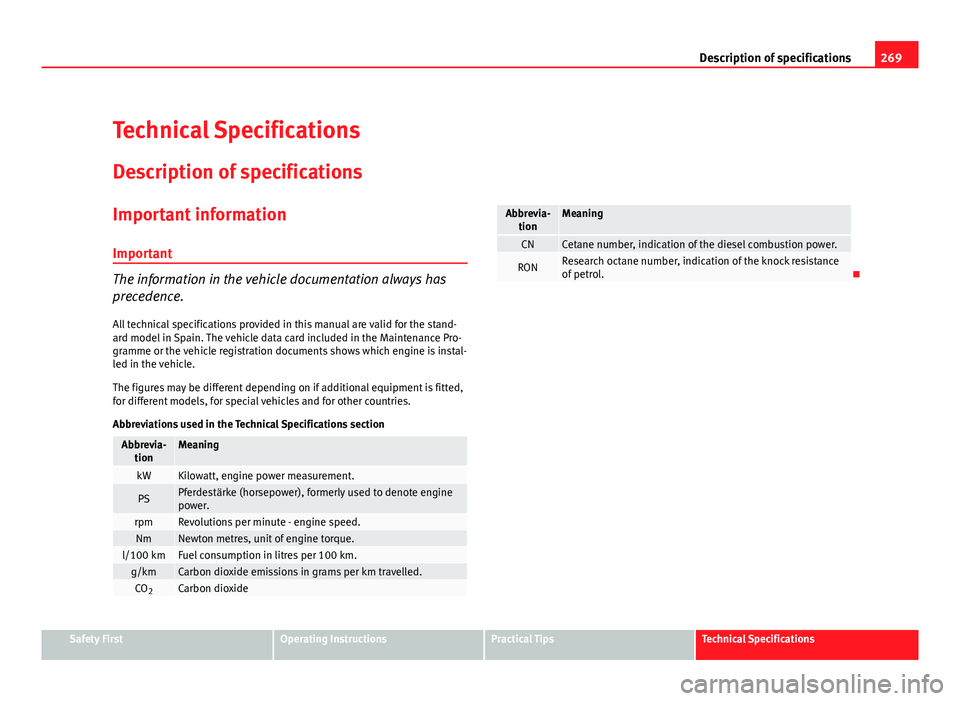
269
Description of specifications
Technical Specifications
Description of specifications Important information
Important
The information in the vehicle documentation always has
precedence. All technical specifications provided in this manual are valid for the stand-
ard model in Spain. The vehicle data card included in the Maintenance Pro-
gramme or the vehicle registration documents shows which engine is instal-
led in the vehicle.
The figures may be different depending on if additional equipment is fitted,
for different models, for special vehicles and for other countries.
Abbreviations used in the Technical Specifications section
Abbrevia- tionMeaning
kWKilowatt, engine power measurement.
PSPferdestärke (horsepower), formerly used to denote engine
power.
rpmRevolutions per minute - engine speed.NmNewton metres, unit of engine torque.l/100 kmFuel consumption in litres per 100 km.g/kmCarbon dioxide emissions in grams per km travelled.CO2Carbon dioxide
Abbrevia-
tionMeaning
CNCetane number, indication of the diesel combustion power.
RONResearch octane number, indication of the knock resistance
of petrol.
Safety FirstOperating InstructionsPractical TipsTechnical Specifications
Page 272 of 302
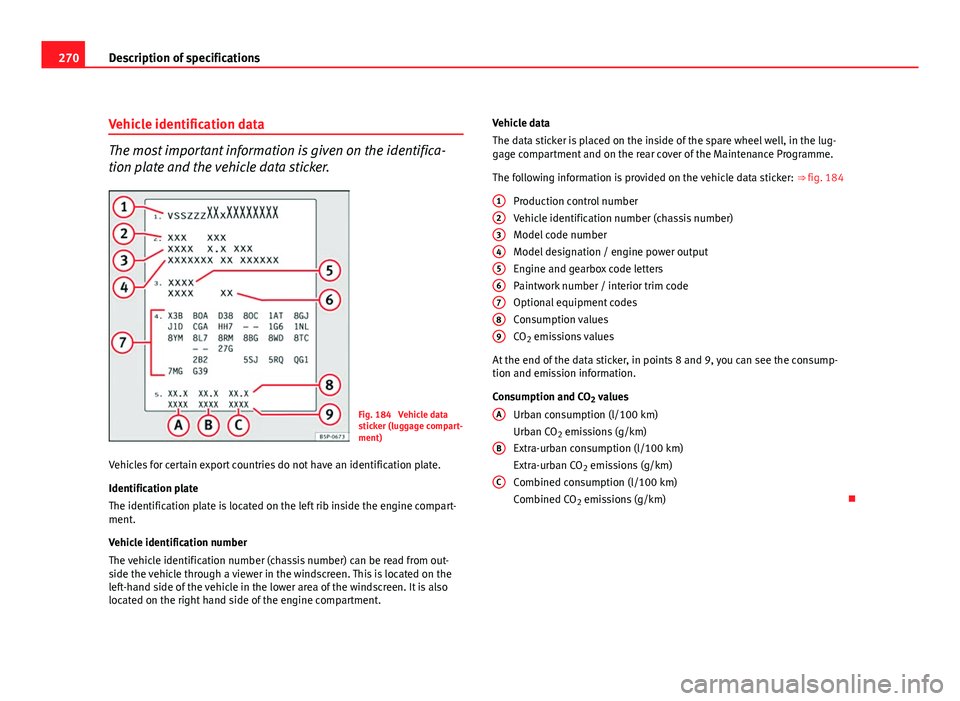
270Description of specifications
Vehicle identification data
The most important information is given on the identifica-
tion plate and the vehicle data sticker.
Fig. 184 Vehicle data
sticker (luggage compart-
ment)
Vehicles for certain export countries do not have an identification plate.
Identification plate
The identification plate is located on the left rib inside the engine compart-
ment.
Vehicle identification number
The vehicle identification number (chassis number) can be read from out-
side the vehicle through a viewer in the windscreen. This is located on the
left-hand side of the vehicle in the lower area of the windscreen. It is also
located on the right hand side of the engine compartment. Vehicle data
The data sticker is placed on the inside of the spare wheel well, in the lug-
gage compartment and on the rear cover of the Maintenance Programme.
The following information is provided on the vehicle data sticker:
⇒ fig. 184
Production control number
Vehicle identification number (chassis number)
Model code number
Model designation / engine power output
Engine and gearbox code letters
Paintwork number / interior trim code
Optional equipment codes
Consumption values
CO 2 emissions values
At the end of the data sticker, in points 8 and 9, you can see the consump-
tion and emission information.
Consumption and CO 2 values
Urban consumption (l/100 km)
Urban CO 2 emissions (g/km)
Extra-urban consumption (l/100 km)
Extra-urban CO 2 emissions (g/km)
Combined consumption (l/100 km)
Combined CO 2 emissions (g/km)
123456789
A
B
C
Page 273 of 302

271
Description of specifications
Information on fuel consumption
Fuel consumption
The consumption and emission details shown on the vehicle
data sticker differ from one vehicle to another. The vehicle's fuel consumption and CO 2 emissions can be consulted on the
vehicle data sticker in the spare wheel well, inside the luggage compart-
ment and on the rear cover of the Maintenance Programme.
The fuel consumption and CO 2 emission values refer to the weight category
assigned to your vehicle according to the engine and gearbox combination,
as well as the specific equipment fitted, and is only used to compare be-
tween the different models.
The fuel consumption and CO 2 emissions do not depend only on the per-
formance of the vehicle, they can also differ from the established values de-
pending on other factors such as driving style, road conditions, traffic con-
ditions, environmental conditions, load and number of passengers.
Calculation of fuel consumption
The consumption values have been calculated based on measurements per-
formed or supervised by certified CE laboratories according to the latest ver-
sion of directives 715/2007/EC and 80/1268/CEE (for more information
consult the European Union Publications Office at EUR-Lex: © European Un-
ion, http://eur-lex.europa.eu/en/index.htm) and are valid for the kerb
weight indicated for the vehicle.
Note
In practice, and considering all the factors mentioned here, consumption
values can differ from those calculated in the current European regulations. Weights
Kerb weight refers to the basic model with a fuel tank filled to 90% capacity
and without optional extras. The figure quoted includes 75 kg to allow for
the weight of the driver.
For special versions and optional equipment fittings or for the addition of
accessories, the weight of the vehicle will increase
⇒
.
WARNING
● Please note that the centre of gravity may shift when transporting
heavy objects; this may affect the vehicle's handling and lead to an acci-
dent. Always adjust your speed and driving style to suit road conditions
and requirements.
● Never exceed the gross axle weight rating or the gross vehicle weight
rating. If the allowed axle load or the allowed total weight is exceeded,
the driving characteristics of the vehicle may change, leading to acci-
dents, injuries and damage to the vehicle.
Towing a trailer Trailer weights
Trailer weight
The trailer weights and drawbar loads approved are selected in intensive tri-
als according to precisely defined criteria. The approved trailer weights are
valid for vehicles in the EU for maximum speeds of 80 km/h (in certain cir-
cumstances up to 100 km/h). The figures may be different in other coun-
tries. All data in the official vehicle documents take precedence over these
data ⇒
.
Safety FirstOperating InstructionsPractical TipsTechnical Specifications
Page 274 of 302
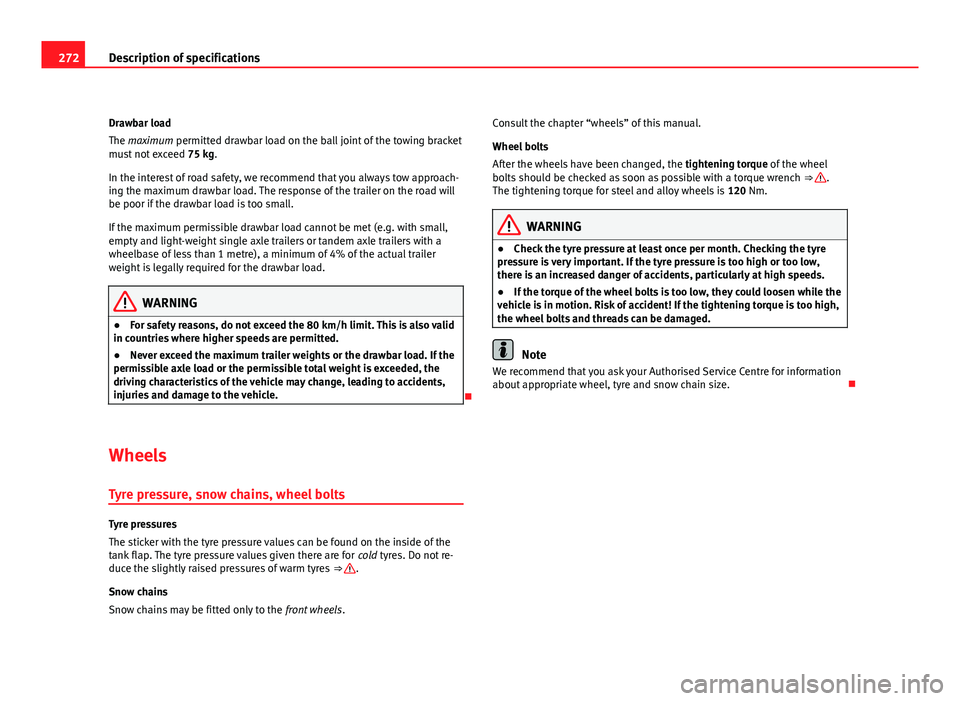
272Description of specifications
Drawbar load
The maximum permitted drawbar load on the ball joint of the towing bracket
must not exceed 75 kg.
In the interest of road safety, we recommend that you always tow approach-
ing the maximum drawbar load. The response of the trailer on the road will
be poor if the drawbar load is too small.
If the maximum permissible drawbar load cannot be met (e.g. with small,
empty and light-weight single axle trailers or tandem axle trailers with a
wheelbase of less than 1 metre), a minimum of 4% of the actual trailer
weight is legally required for the drawbar load.
WARNING
● For safety reasons, do not exceed the 80 km/h limit. This is also valid
in countries where higher speeds are permitted.
● Never exceed the maximum trailer weights or the drawbar load. If the
permissible axle load or the permissible total weight is exceeded, the
driving characteristics of the vehicle may change, leading to accidents,
injuries and damage to the vehicle.
Wheels
Tyre pressure, snow chains, wheel bolts
Tyre pressures
The sticker with the tyre pressure values can be found on the inside of the
tank flap. The tyre pressure values given there are for cold tyres. Do not re-
duce the slightly raised pressures of warm tyres ⇒
.
Snow chains
Snow chains may be fitted only to the front wheels. Consult the chapter “wheels” of this manual.
Wheel bolts
After the wheels have been changed, the
tightening torque of the wheel
bolts should be checked as soon as possible with a torque wrench ⇒
.
The tightening torque for steel and alloy wheels is 120 Nm.
WARNING
● Check the tyre pressure at least once per month. Checking the tyre
pressure is very important. If the tyre pressure is too high or too low,
there is an increased danger of accidents, particularly at high speeds.
● If the torque of the wheel bolts is too low, they could loosen while the
vehicle is in motion. Risk of accident! If the tightening torque is too high,
the wheel bolts and threads can be damaged.
Note
We recommend that you ask your Authorised Service Centre for information
about appropriate wheel, tyre and snow chain size.
Page 275 of 302
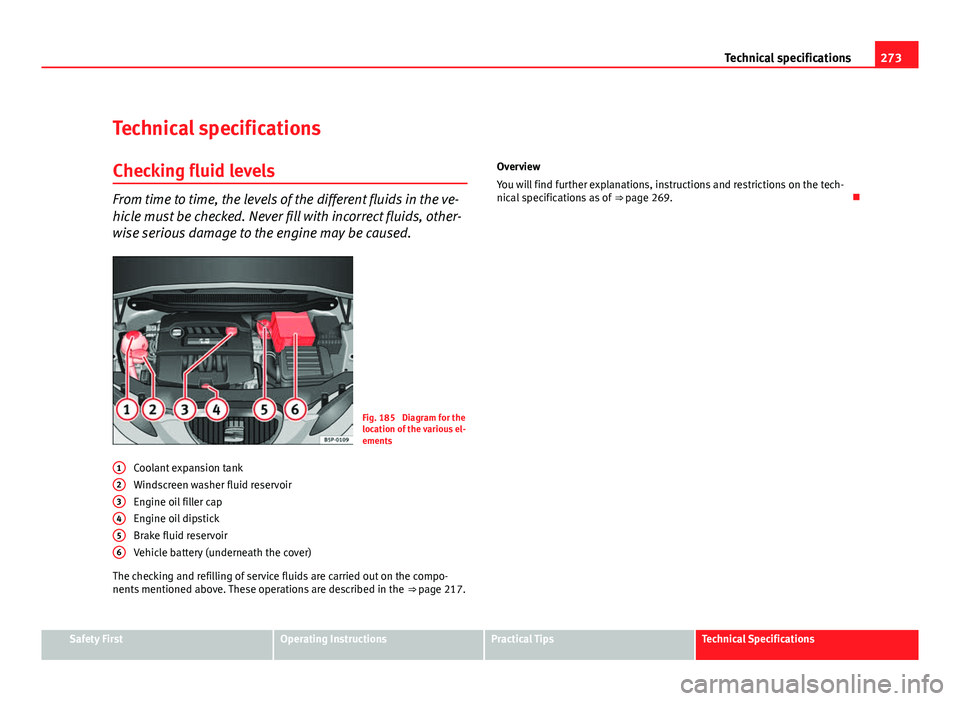
273
Technical specifications
Technical specifications
Checking fluid levels
From time to time, the levels of the different fluids in the ve-
hicle must be checked. Never fill with incorrect fluids, other-
wise serious damage to the engine may be caused.
Fig. 185 Diagram for the
location of the various el-
ements
Coolant expansion tank
Windscreen washer fluid reservoir
Engine oil filler cap
Engine oil dipstick
Brake fluid reservoir
Vehicle battery (underneath the cover)
The checking and refilling of service fluids are carried out on the compo-
nents mentioned above. These operations are described in the ⇒ page 217.
1
23456
Overview
You will find further explanations, instructions and restrictions on the tech-
nical specifications as of
⇒ page 269.
Safety FirstOperating InstructionsPractical TipsTechnical Specifications
Page 276 of 302
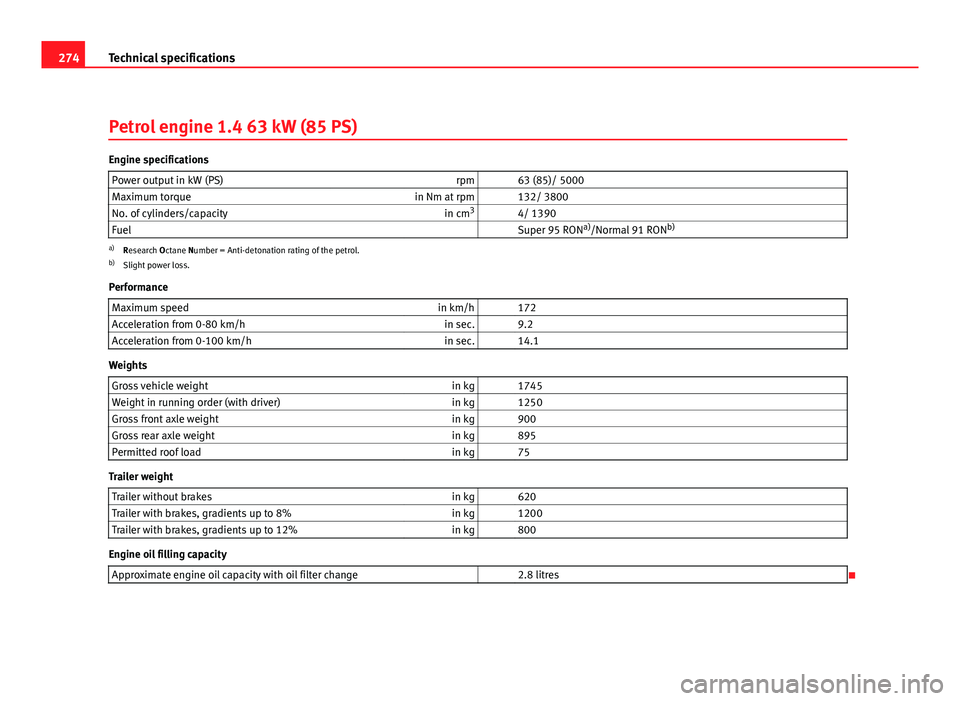
274Technical specifications
Petrol engine 1.4 63 kW (85 PS)
Engine specifications
Power output in kW (PS) rpm 63 (85)/ 5000
Maximum torque in Nm at rpm 132/ 3800
No. of cylinders/capacity in cm3
4/ 1390
Fuel Super 95 RON a)
/Normal 91 RON b)
a)
Research Octane Number = Anti-detonation rating of the petrol.
b) Slight power loss.
Performance Maximum speed in km/h 172
Acceleration from 0-80 km/h in sec. 9.2
Acceleration from 0-100 km/h in sec. 14.1
Weights
Gross vehicle weight in kg 1745
Weight in running order (with driver) in kg 1250
Gross front axle weight in kg 900
Gross rear axle weight in kg 895
Permitted roof load in kg 75
Trailer weight
Trailer without brakes in kg 620
Trailer with brakes, gradients up to 8% in kg 1200
Trailer with brakes, gradients up to 12% in kg 800
Engine oil filling capacity
Approximate engine oil capacity with oil filter change 2.8 litres
Page 277 of 302
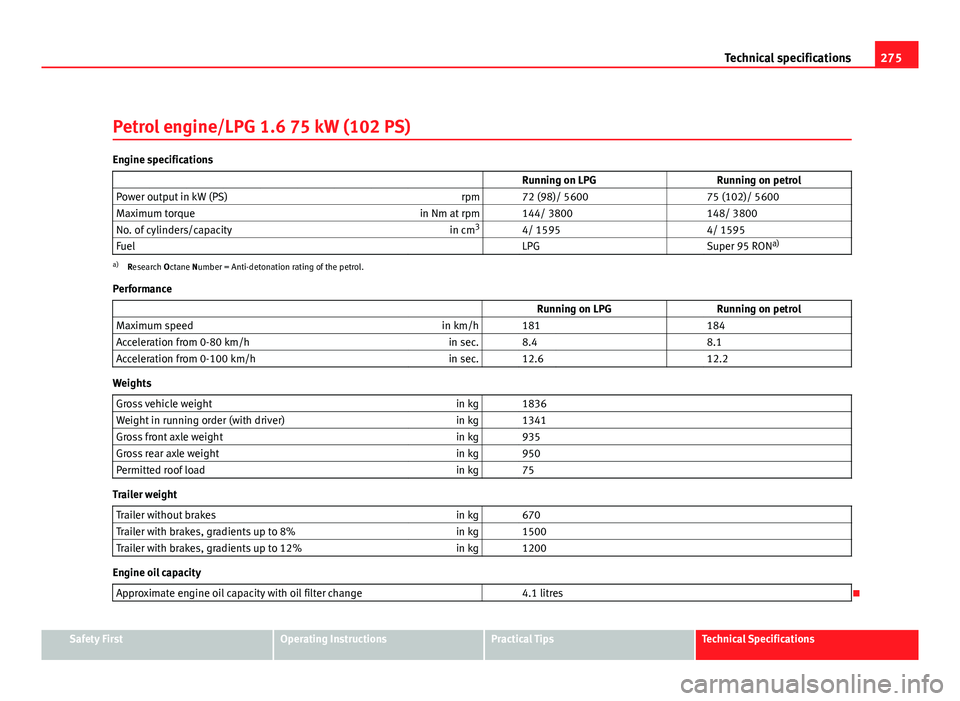
275
Technical specifications
Petrol engine/LPG 1.6 75 kW (102 PS)
Engine specifications Running on LPG Running on petrol
Power output in kW (PS) rpm 72 (98)/ 5600 75 (102)/ 5600
Maximum torque in Nm at rpm 144/ 3800 148/ 3800
No. of cylinders/capacity in cm3
4/ 1595 4/ 1595
Fuel LPG Super 95 RONa)
a)
Research Octane Number = Anti-detonation rating of the petrol.
Performance Running on LPGRunning on petrol
Maximum speed in km/h 181 184
Acceleration from 0-80 km/h in sec. 8.4 8.1
Acceleration from 0-100 km/h in sec. 12.6 12.2
Weights
Gross vehicle weight in kg 1836
Weight in running order (with driver) in kg 1341
Gross front axle weight in kg 935
Gross rear axle weight in kg 950
Permitted roof load in kg 75
Trailer weight
Trailer without brakes in kg 670
Trailer with brakes, gradients up to 8% in kg 1500
Trailer with brakes, gradients up to 12% in kg 1200
Engine oil capacity
Approximate engine oil capacity with oil filter change 4.1 litres
Safety FirstOperating InstructionsPractical TipsTechnical Specifications
Page 278 of 302
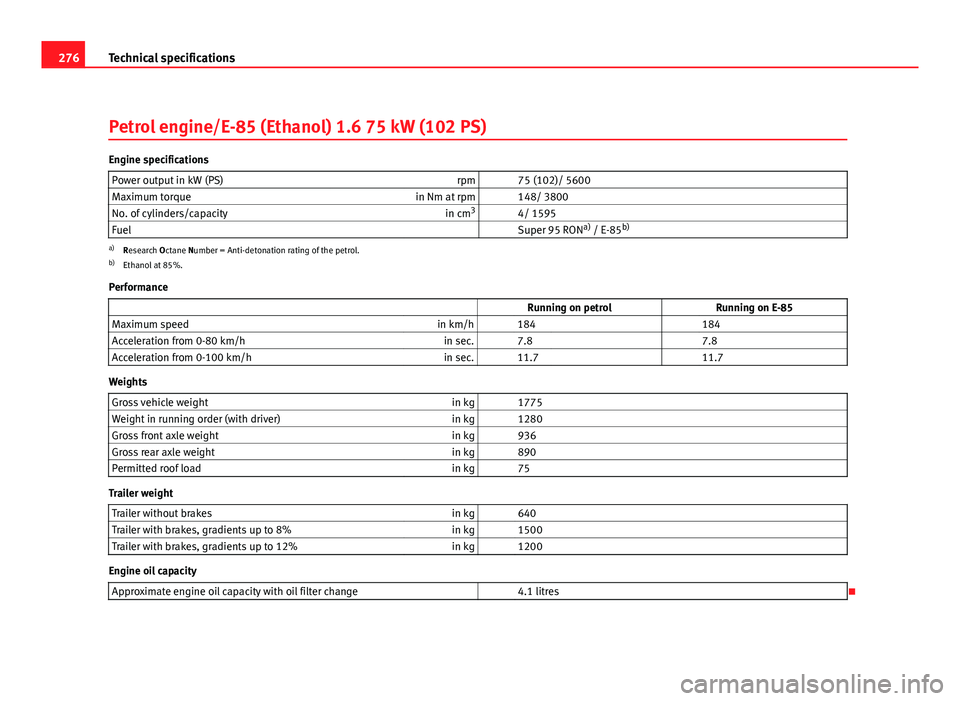
276Technical specifications
Petrol engine/E-85 (Ethanol) 1.6 75 kW (102 PS)
Engine specifications
Power output in kW (PS) rpm 75 (102)/ 5600
Maximum torque in Nm at rpm 148/ 3800
No. of cylinders/capacity in cm3
4/ 1595
Fuel Super 95 RONa)
/ E-85 b)
a)
Research Octane Number = Anti-detonation rating of the petrol.
b) Ethanol at 85%.
Performance Running on petrolRunning on E-85
Maximum speed in km/h 184 184
Acceleration from 0-80 km/h in sec. 7.8 7.8
Acceleration from 0-100 km/h in sec. 11.7 11.7
Weights
Gross vehicle weight in kg 1775
Weight in running order (with driver) in kg 1280
Gross front axle weight in kg 936
Gross rear axle weight in kg 890
Permitted roof load in kg 75
Trailer weight
Trailer without brakes in kg 640
Trailer with brakes, gradients up to 8% in kg 1500
Trailer with brakes, gradients up to 12% in kg 1200
Engine oil capacity
Approximate engine oil capacity with oil filter change 4.1 litres
Page 279 of 302

277
Technical specifications
Petrol engine 1.2 77 kW (105 PS)
Engine specifications Power output in kW (PS) rpm 77 (105)/5000
Maximum torque in Nm at rpm 175/1550-4100
No. of cylinders/capacity in cm3
4/ 1197
Fuel Super 95 RON a)
/Normal 91 RON b)
a)
Research Octane Number = Anti-detonation rating of the petrol.
b) With a slight power loss
Performance without Start-Stopwith Start-Stop
Maximum speed in km/h 187 187
Acceleration from 0-80 km/h in sec. 7.2 7.2
Acceleration from 0-100 km/h in sec. 10.9 10.9
Weights
without Start-Stop with Start-Stop
Gross vehicle weight in kg 1770 1775
Weight in running order (with driver) in kg 1275 1280
Gross front axle weight in kg 940 940
Gross rear axle weight in kg 890 890
Permitted roof load in kg 75 75
Trailer weight
without Start-Stopwith Start-Stop
Trailer without brakes in kg 630 640
Trailer with brakes, gradients up to 8% in kg 1500 1500
Trailer with brakes, gradients up to 12% in kg 1200 1200
Safety FirstOperating InstructionsPractical TipsTechnical Specifications
Page 280 of 302
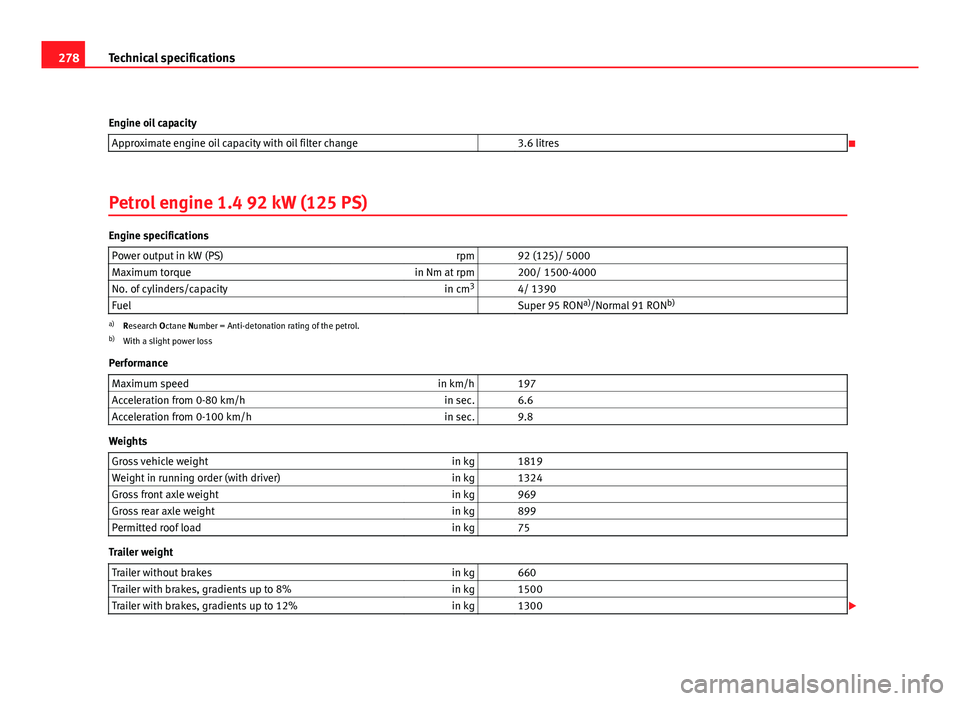
278Technical specifications
Engine oil capacity Approximate engine oil capacity with oil filter change 3.6 litres
Petrol engine 1.4 92 kW (125 PS)
Engine specifications Power output in kW (PS) rpm 92 (125)/ 5000
Maximum torque in Nm at rpm 200/ 1500-4000
No. of cylinders/capacity in cm3
4/ 1390
Fuel Super 95 RON a)
/Normal 91 RON b)
a)
Research Octane Number = Anti-detonation rating of the petrol.
b) With a slight power loss
Performance Maximum speed in km/h 197
Acceleration from 0-80 km/h in sec. 6.6
Acceleration from 0-100 km/h in sec. 9.8
Weights
Gross vehicle weight in kg 1819
Weight in running order (with driver) in kg 1324
Gross front axle weight in kg 969
Gross rear axle weight in kg 899
Permitted roof load in kg 75
Trailer weight
Trailer without brakes in kg 660
Trailer with brakes, gradients up to 8% in kg 1500
Trailer with brakes, gradients up to 12% in kg 1300